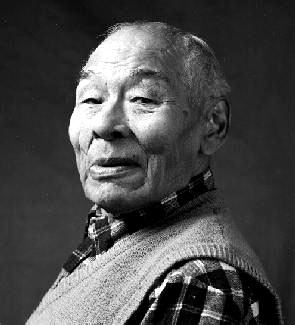Pudlo Pudlat facts for kids
Pudlo Pudlat (born February 4, 1916 – died December 28, 1992) was a famous Inuit artist from Canada. He loved to draw and paint, mostly using acrylic paints and colored pencils. His artworks are now in many museums across Canada. When he passed away in 1992, Pudlo had created over 4,000 drawings and 200 prints!
Biography
Pudlo Pudlat was born in a place called Kamadjuak Camp on Baffin Island, Canada. For most of his life, he lived in the Kimmirut area, which is now part of Nunavut. He spent his early life hunting and fishing with his family along the coast of Baffin Island.
In the early 1960s, Pudlo stopped living a traveling lifestyle and settled in Cape Dorset. This was a time when life in the Arctic was changing a lot, especially in the 1950s. In 1950, he married another Inuit artist named Innukjuakju Pudlat. They were together until she passed away in 1972.
When he was young, Pudlo lived near Coral Harbour. Later, he moved to the area now called Kimmirut. In the late 1950s, when he was already in his 40s, he moved to Kiaktuuq near Cape Dorset. He went there to get better after being sick with tuberculosis. It was there that he met James Archibald Houston, who helped start Inuit art. This meeting began Pudlo's amazing career as an artist.
Pudlo spent 33 years making art. He first tried carving sculptures, but it was hard for him because of an arm injury. So, around 1959 or 1960, he started drawing instead. He was encouraged by James Houston and later by Terry Ryan from the West Baffin Eskimo Cooperative. Pudlo really enjoyed drawing, and later he also started making prints and paintings as these art forms became popular in the North.
Sometimes, Pudlo traveled to other parts of Canada or the Arctic for medical care. The things he saw on these trips, especially airplanes, often appeared in his drawings.
In 1972, one of Pudlo's prints was chosen to be on a UNICEF greeting card. Pudlo traveled to Ottawa to see an art show where his work was displayed. He remembered this as the first time he was invited south and recognized publicly for his art.
Pudlo passed away in 1992 in Cape Dorset. His last prints were included in the Cape Dorset Print collection and catalogue in 1993.
Important Moments in Pudlo's Art Career

- 1990 - A big art show called "Pudlo: Thirty Years of Drawing" opened at the National Gallery of Canada. It was the first time an Inuit artist had a solo show there.
- 1989 - Pudlo traveled to Mannheim, Germany, for the opening of his own art show at the Inuit Galerie.
- 1980 - Pudlo created a special lithograph (a type of print) called "In Celebration." It was made to celebrate the anniversary of the Canadian Guild of Crafts in Montreal, Quebec.
- 1979 - He was asked by the Canadian Guild of Crafts Quebec to make another lithograph. This one celebrated the first art show of modern Inuit art at the Guild in Montreal.
- 1979 - Pudlo made a print called "Shores of the Settlement" for the Queen Elizabeth Hotel. It honored 29 "Great Montrealers." Pudlo traveled to Montreal for the event.
- 1978 - The Department of Indian Affairs and Northern Development asked Pudlo to create two designs for banners. Pudlo went to Oakville, Ontario, to work on these designs at Sheridan College.
- 1978 - Pudlo's print from 1976, called "Aeroplane," was put on a Canadian postage stamp!
- 1976 - Pudlo was one of four artists from Kinngait (Cape Dorset) who made prints for the first UN Habitat Conference in Vancouver, British Columbia.
- 1976 - He attended the opening of the annual Kinngait (Cape Dorset) print collection in Toronto.
- 1972 - One of Pudlo Pudlat’s designs, along with designs from four other Canadian Inuit artists, was chosen for a series of UNICEF greeting cards.
Artistic Themes
Pudlo's art often shows a fun sense of humor. He was also very interested in modern things, especially airplanes. His first drawings were simple outlines made with a pencil. In the mid-1960s, Pudlo started using colored pencils and felt-tipped pens, and his art became more detailed.
Pudlo's work often showed the interesting mix of traditional Inuit culture and modern life. He was very good at seeing things and was always trying new ideas in his art. He used his humor and his knowledge of the old ways of living on the land. He also showed how times were changing. Pudlo once said about his drawing, "At times when I draw, I am happy, but sometimes it is very hard. I have been drawing a long time now. I only draw what I think, but sometimes I think the pencil has a brain too."


